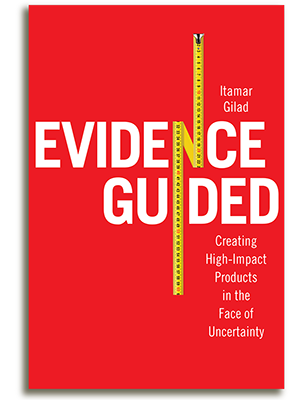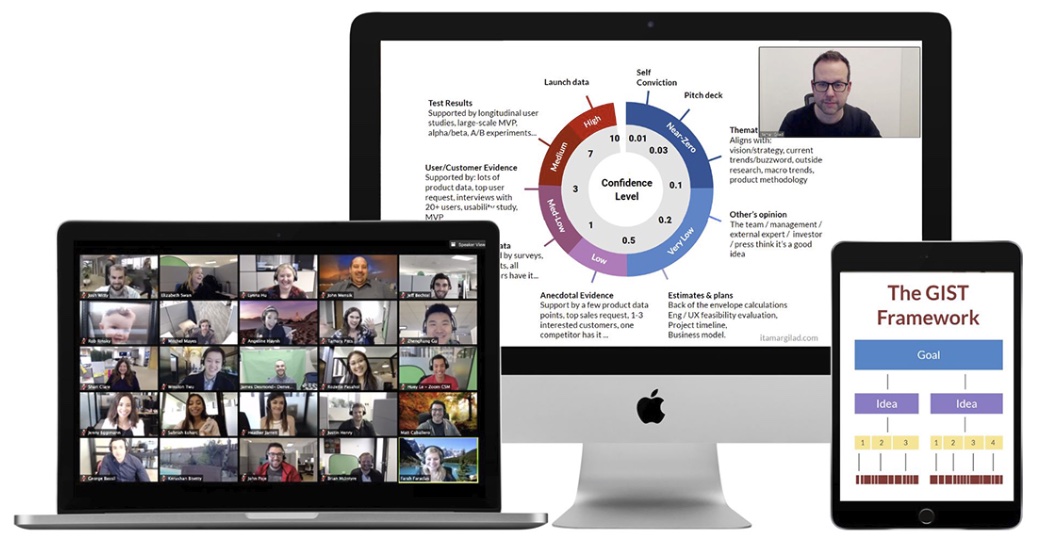There’s a popular notion that we should copy the playbooks of the most successful tech companies, aka Big Tech. The most obvious sources of inspiration are the FAANG companies: Facebook, Apple, Amazon, Netflix, and Google. So you may be told to Work Backwards like Amazon, use OKRs and 20% projects like Google, or organize according to the Spotify Model. These mega-successful companies obviously know something we don’t, so using their processes sounds like a logical shortcut to success.
A Messy Reality
People who’ve worked for Big Tech will tell you that not all that shines is gold. Once you’re inside it becomes abundantly clear that these companies do not have a fail-proof recipe for product success. In fact there’s an awful lot of product failure and waste. Big Tech companies have very deep pockets and can afford to try out many things, just for the odd chance of finding a big win. This strategy of “seeing what sticks” works, but is very wasteful, which is why I’m seeing Big Tech firms working to improve product discovery and evidence-guided development.
Second, there’s often a gap between what we’re told company X is doing, and what it is doing in practice. Big Tech companies are large and diverse. There’s usually more than just “one right way” to do things. The processes can be fuzzy and they keep evolving. For example, according to the book Working Backwards, Amazon had long ago iterated away from the concept of two-pizza-box teams (self-contained, autonomous product teams that own a discrete part of the product with clear interfaces) to single-threaded-leaders (self-contained product areas that are devoted to only mission). Similarly, Spotify had likely experimented with the so-called Spotify model, but didn’t use it for long. During my time at Google there was a shift from 20% projects to hackathons, and the use of OKRs (especially personal OKRs) wasn’t uniform.
Conflicting Approaches
It’s also evident that Big Tech companies do not always agree on best practices. At Amazon, major product ideas have to be approved by managers in detailed reviews that go up the chain of command (this a key part of the Working Backwards process). At Netflix, managers are taught to lead with context, giving reports as much strategic guidance as possible and then leaving the decisions to them. Both systems combine managerial control and delegation, but they take very different approaches. You might say they’re in disagreement.
Which leads to a key point: Big Tech processes are not universal. Amazon has massive logistical and supply-chain sides that require business planning and managerial oversight. Netflix is a pure software/content company dealing with creative mediums and consumer tastes, so managers’ opinions aren’t necessarily the most important input. Each company iterated its way to a development philosophy and set of practices that suit its needs and its culture. The big question is if any of these custom-tailored processes will work for your company.
Join thousands of of product people who receive my newsletter High Impact Product Management to get articles like this one, plus eBooks, templates and other resources in your inbox.
Principles Before Process
I strongly believe we should learn from the most successful companies. However, process may not be the right place to start. In the 1990s Toyota emerged as a dominant force in the car industry, but attempts to copy its famous Toyota Production System have largely failed. That’s because what was copied were the processes but not Toyota’s underlying philosophy. Over time, some principles such as limiting work in progress were distilled and accepted, which is why today we benefit from Toyota-inspired processes like Kanban boards.
The key point of this article is this: Big Tech companies (as well as smaller companies that create great products) are magical not because they invented the best processes, but because they’re deeply committed to a company culture, a product philosophy, and a set of development principles. The processes are just at the surface-level.
Here are some principles and practices that all good tech companies adhere to:
- Customer-focus — The most successful companies put the customer at the center of everything they do. My managers at Google pushed me to delay important projects until we reached a high bar of user value. Every Googler I worked with, from engineers to lawyers, cared deeply for the experience of the users. I believe that’s why Google has such a devoted user base. The same is true for other FAANG companies as well.
- Hiring great people — Getting hired by any of the FAANG companies is a grueling, lengthy process. That’s because they only want the right people to get in. The definition of “right” is consistent — highly-capable people who are easy to work with and match the mindset of the company (sometimes called “culture fit”). Obviously not everyone can afford to offer FAANG-level salaries and benefits, but I do see a lot of companies that are not even trying to find the right people, and are just filling headcount, often with people that fit the job description on paper only.
- Empowered cross-functional product teams — As a product person you’re likely to work in a semi-autonomous product team (what Marty Cagan calls empowered teams), led by a PM, an engineering lead, and sometimes a UX designer, and staffed by a non-rotating group of engineers. The team will have a clear area of responsibility and will be expected to solve real problems for customers and for the business. Your ideas will be considered seriously.
- Business doesn’t run the show — In great product companies it’s very unlikely that a product person will report to a MBA-trained “professional manager” that has never built anything. Suggesting that a committee of business stakeholders would decide what to put into the product will get you laughed out of the room. The input of the business is very important, and the product org collaborates closely with Sales and Marketing, but the notion that the product is there to do the bidding of the business simply doesn’t exist.
- Being bold and questioning conventions — The best tech companies are irreverent of how things work today and preoccupied with what could be. They see the world as full of problems to solve, opportunities to seize, and disruptions to create. They’re nothing like the average company that just wishes to fit into the status-quo and build more or less the same thing everyone else builds (perhaps slightly better or slightly cheaper). The willingness to explore and take risk extends inwards to everything the company does.
- Continuous iteration and feedback loops — From Google’s early beta products to Netflix’s A/B testing, Big-Tech companies know that great products are a result of endless iteration and testing with users. Even Apple’s products, which we experience fully built and polished, are a result of intensive iteration, mostly done internally with Apple employees. Adapting the plan in light of new information is normal and desirable, and even senior leaders are willing to change their minds given contradicting data.
We learn in-depth how to implement the best product principles in my Lean Product Management courses. Secure your ticket for the next public workshop or contact me to organize an in-house workshop for your team. Learn more at itamargiladcom/workshops.
Looking Broader and Deeper
I was lucky to have worked for three big tech companies: IBM in the 1990s, Microsoft in the early 2000s, and Google in the 2010s. Each, for a time, was considered a model of success. My impression is that, contrary to what senior executives may tell you in their books, no company had discovered a universal solution for product innovation and business success. They invented something powerful that works for them, but there are always tradeoffs. More importantly, their process may not work for you.
To properly learn from the success of Big-Tech companies we need to analyze what they do with a broader lens: company history, corporate culture, founder personalities, and luck. We shouldn’t stop at one — it’s much more powerful to compare and contrast multiple companies and to synthesize the common attributes of success (see list above). In my courses I give many examples from Big Tech, but I don’t teach the Google way nor the Microsoft way. Instead, like other coaches, I try to offer general principles and frameworks that are inspired, but not directly copied from the best companies. You don’t have to use my frameworks (which are inspired by other peoples’ of course), but you should strive to develop a clear development philosophy for your company. Once you have this base you can choose what processes to adopt. You can mix and match or even invent your own.
If you want to do your own research, I’m including a list of books that shed light on the histories and workings of FAANG — highly recommend reading for any product person:
- Google: In the Plex / Steven Levy, How Google Works / Eric Schmidt and Jonathan Rosenberg, The Google Story / David A. Vise and Mark Malseed
- Apple: The one device / Brian Merchant , Creative Selection / Ken Cocienda
- Amazon: The everything store / Brad Stone, Working Backwards / Colin Bryar, Bill Carr
- Netflix: No Rules Rule / Reed Hastings, Erin Meyer
- Facebook and other Silicon Valley companies: Valley of the Genius / Adam Fisher
Join 15,000 product people who receive my articles, tools, and templates in their inbox



Thanks for sharing these insights. In companies that support Technical Program Management, how is this role realized in the above principals?
Hi Jennifer. I think technical project management can play an important role when these principles are employed – especially in big companies, and with big goals. During the discovery phases the TPM can help with facilitating the resources for testing and experiments, collecting and sharing information, and cross-functional coordination. When we’ve discover a big idea that is sufficiently validated, and we switch gears into delivery, we can use TPMs in a more “classic” approach to coordinate work towards a launch, although I’d still advocate a light touch and allowing team to be somewhat independent.